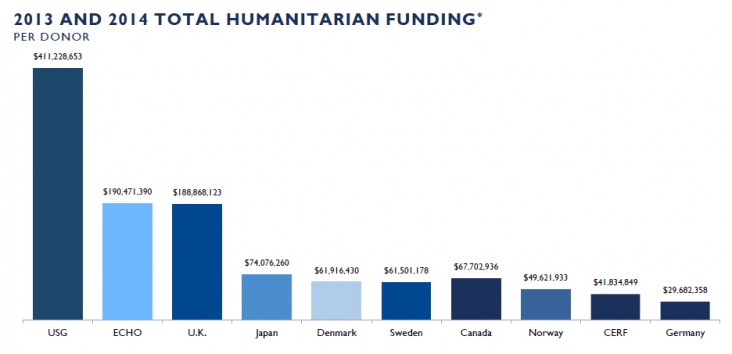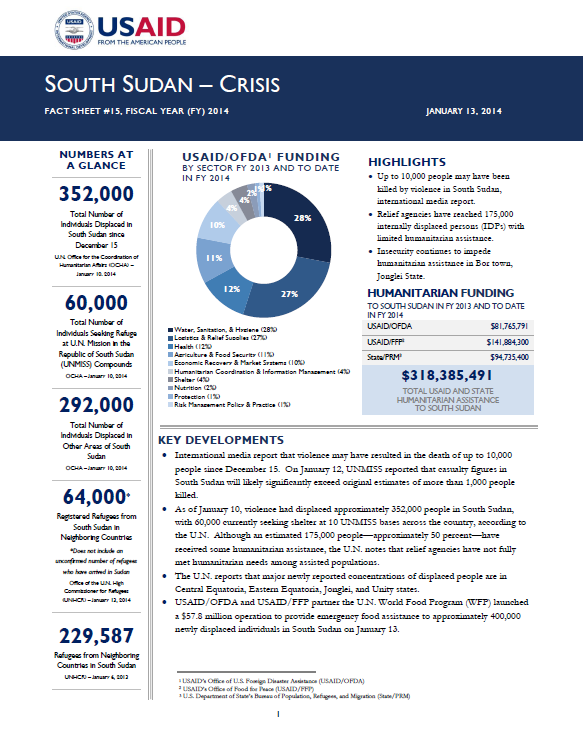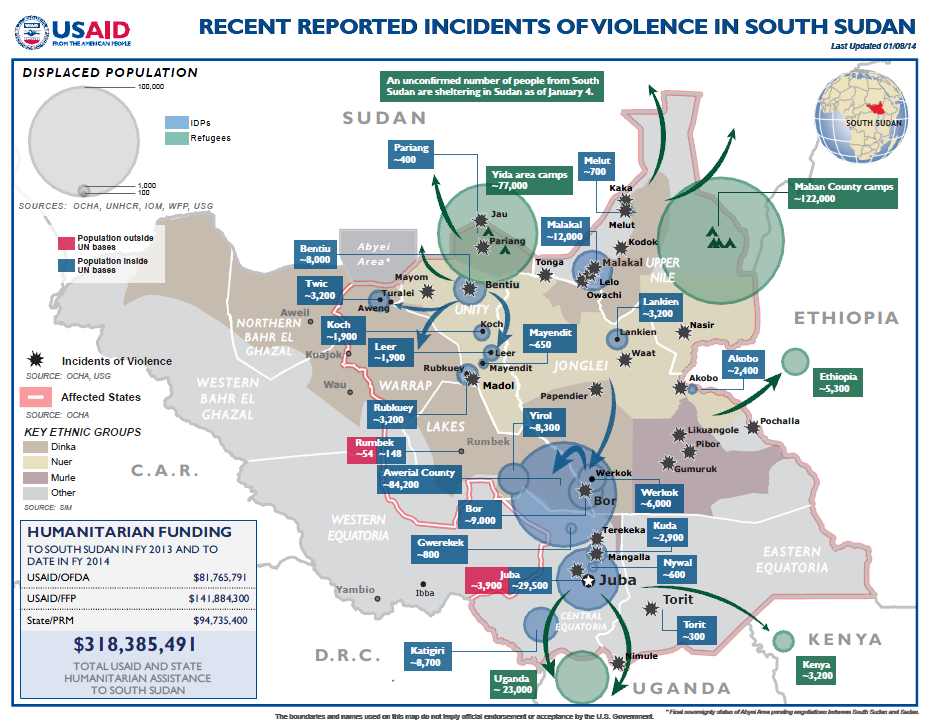- What We Do
- Agriculture and Food Security
- Democracy, Human Rights and Governance
- Economic Growth and Trade
- Education
- Environment and Global Climate Change
- Gender Equality and Women's Empowerment
- Global Health
- Humanitarian Assistance
- Transformation at USAID
- Water and Sanitation
- Working in Crises and Conflict
- U.S. Global Development Lab
Speeches Shim
January 15, 2013
Numbers At A Glance
413,000
66,500
346,500
74,300
229,587
Humanitarian Funding:
To South Sudan To Date In FY2013 and FY2014:
| USAID/OFDA | $81,765,791 |
| USAID/FFP | $141,884,300 |
| State/PRMDoD | $94,735,400 |
| TOTAL | $318,385,491 |
Highlights
Internally displaced persons (IDPs) continue to flee to Awerial County, Lakes State.
Relief agencies reach 203,000 people with limited humanitarian assistance.
U.N. condemns the commandeering of humanitarian vehicles and theft of food stocks in South Sudan.
KEY DEVELOPMENTS
On January 14, U.N. Secretary-General Ban Ki-Moon condemned the commandeering of humanitarian vehicles and theft of food stocks and other relief items by Government of the Republic of South Sudan and opposition forces. Ban Ki-Moon reiterated that the U.N. will hold armed actors accountable for attacks against civilians, humanitarian workers, and U.N. personnel.
As of January 13, violence had displaced approximately 413,000 people in South Sudan, with 66,500 people currently seeking shelter at UNMISS bases across the country, according to the U.N. Although an estimated 203,000 people have received some humanitarian assistance, the U.N. notes that relief agencies have not fully met needs among assisted populations due to a lack of sustained, predictable access.
USAID/OFDA partner the International Organization for Migration (IOM) continues to co-lead the Camp Coordination and Management Cluster—the coordinating body for camp coordination and management activities, comprising U.N. agencies, non-governmental organizations (NGOs), and other stakeholders—in South Sudan and is currently registering IDPs for humanitarian assistance in Bentiu town, Unity State, and Malakal town, Upper Nile State.
SITUATION AND DISPLACEMENT UPDATE
Ongoing hostilities in many areas of South Sudan continue to impede the delivery of critical humanitarian assistance to vulnerable populations. Despite constraints, humanitarian agencies are providing support as access and security allow and have reached approximately 203,000 people with limited humanitarian assistance as of January 13.
International media report that people fleeing Jonglei State violence continue to seek shelter in Minkamman, Lakes State, with more than 1,000 IDPs arriving daily.
Ongoing hostilities across South Sudan resulted in additional population displacement, and the U.N. reports that nearly 18,000 people are currently sheltering at the UNMISS base in Malakal, representing a 50 percent increase since January 13.
On January 15, humanitarian partners completed an initial rapid needs assessment of Lankien town, Jonglei State, where approximately 30,000 IDPs are residing. Assessment results are forthcoming.
UNHCR reports more than 42,000 refugees fleeing violence from South Sudan have sought refuge in Uganda. The Dzaipi transit center in northern Uganda—which was originally designed to host approximately 400 individuals—has the largest concentration of refugees from South Sudan, with more than 32,500 people. UNHCR notes health care for the refugees remains a concern, with limited medical supplies, staff, and hygiene tools available. The Government of Uganda and UNHCR are working to open an alternative refugee host site in the coming days.
South Sudan Crisis Fact Sheet #17 January 15, 2014 ![]() (pdf - 371k)
(pdf - 371k)
HUMANITARIAN RESPONSE IN JUBA, CENTRAL EQUATORIA STATE
As of January 14, International Medical Corps (IMC) had established a second primary health care clinic at UNMISS Tong Ping and planned to begin services in the coming days. IMC reported that 32 percent of 750 patients had an upper respiratory infection, 21 percent of patients had malaria, and 7.5 percent of patients had acute watery diarrhea during medical consultations at U.N. House 3 conducted between January 6 and January 12.
In other non-UNMISS IDP sites in Juba, humanitarian agencies are distributing relief items based on need, with small-scale distributions ongoing.
Relief agencies have not met humanitarian standards for shelter provision for IDPs due to the limited amount of secure land inside UNMISS bases and the remote nature of many spontaneous IDP sites. The Health Cluster reports that due to insufficient shelter at IDP sites, the risk of respiratory tract infections and malaria remains of concern. Relief agencies are working to identify and prepare an additional IDP site in Juba where UNMISS will provide physical protection of civilians.
HUMANITARIAN NEEDS AND RESPONSE IN OTHER AREAS OF SOUTH SUDAN
To address expanding camp management needs, USAID/OFDA partner IOM has deployed 28 staff to South Sudan in recent days, increasing IOM’s presence to 44 total personnel. Since fighting began on December 15, USAID/OFDA has awarded more than $2 million through the IOM-managed Rapid Response Fund (RRF), with partners focusing on camp coordination and management, health, protection, relief item, shelter, and water, sanitation, and hygiene (WASH) needs among IDPs.
USAID/FFP partner the U.N. World Food Program (WFP) completed 30-day food ration distributions in Bor town, Jonglei State, reaching all 9,000 IDPs located in the UNMISS compound.
South Sudan Crisis Map #17, January 15, 2014 ![]() (pdf - 436k)
(pdf - 436k)
Insufficient fuel supplies in South Sudan could impede emergency relief operations in the coming weeks. The Health Cluster reports that critical supply chains for the delivery of medical items are facing potential fuel shortages. Without sufficient fuel, relief agencies would become unable to transport supplies and administer measles and polio vaccinations, particularly in areas affected by recent violence, such as Bentiu, Bor, and Malakal towns. The U.N. Children’s Fund (UNICEF), the Health Cluster, and the RSS Ministry of Health are coordinating with UNMISS regarding the delivery of fuel to locations where humanitarian access is limited.
Médecins Sans Frontières (MSF) has provided emergency medical assistance for more than 100 wounded people following heavy fighting in Malakal and Nasir towns, Upper Nile State. In recent weeks, MSF has treated more than 650 people wounded in fighting across South Sudan.
With $340,000 from the RRF, the Danish Refugee Council (DRC) is providing camp coordination and management services, emergency relief supplies, protection assistance, and shelter support to IDPs in Malakal. As part of its camp management responsibilities, DRC is working to manage the sudden influx of additional IDPs to the UNMISS base in Malakal town by designating safe defecation areas within the compound, as latrines remain extremely limited.
Relief agencies have distributed 45-day rations of food commodities and soap to nearly 121,000 refugees in Maban County, Upper Nile. At the Yida and Ajuong Thok refugee camps in Unity State, humanitarian organizations plan to begin food distributions to refugees on January 15.
To help nearly 390 people of South Sudanese origin who have recently returned from Sudan reach Juba, IOM—with support from USAID/OFDA—conducted flights to bring returnees to Juba between January 10 and 13. The flights brought the refugees from a way station in Malakal town, where they were temporarily residing.
Relief agencies are exploring intervention options and supporting vaccination campaigns with the RSS Ministry of Health. The Health Cluster reports that relief agencies are planning measles vaccination campaigns in Awerial, Bentiu, Bor, and Malakal, as well as Turalei town, Warrap State.
Relief organizations continue to respond to the needs of displaced populations in Awerial. The International Federation of Red Cross and Red Crescent Societies, in coordination with the International Committee of the Red Cross (ICRC), is supporting the South Sudan Red Cross to conduct health and hygiene promotion activities in the county.

2013 TOTAL HUMANITARIAN FUNDING*
*Funding figures are as of January 15, 2014. All international figures are according to OCHA’s Financial Tracking Service (FTS) and based on international commitments during the 2013 and 2014 calendar years, while USG figures are according to the USG and reflect the most recent USG commitments based on the 2013 fiscal year, which began on October 1, 2012, and ended September 30, 2013, as well as the 2014 fiscal year, which began on October 1, 2013.



Comment
Make a general inquiry or suggest an improvement.